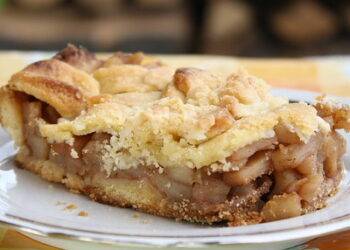Sernik, Poland’s cherished version of cheesecake, stands out for its rich texture and unique flavor, primarily due to the use of twaróg, a type of fresh cheese. This dessert is a staple at Polish celebrations and gatherings. For those unfamiliar, twaróg is similar to farmer’s cheese or ricotta, but with a distinct tang and texture that’s key to authentic Sernik. Here’s a beginner-friendly guide to creating this delightful dessert, including tips to ensure it tastes homemade.
Tracing the origins of Sernik leads us back to the medieval times when its earliest versions were likely baked. Initially a luxury for the nobility, the ingredients and methods evolved, making Sernik accessible and beloved by all. Its main ingredient, twaróg (a type of fresh Polish cheese), distinguishes Sernik from other cheesecakes, offering a unique taste and texture that have been perfected over centuries.
If you can’t find Twaróg in any shops around you – try making your own (click for recipe)
This traditional Polish cheesecake, known for its rich, creamy texture and delicate flavor, is more than just a sweet treat; it’s a piece of Polish heritage. Whether it graces the table at family gatherings, holidays, or celebratory feasts, Sernik embodies the warmth, hospitality, and culinary prowess of Poland. Join us as we embark on a flavorful journey into the history of Sernik, unravel the secrets to its preparation, and share tips that will elevate your Sernik from simply delicious to truly sublime.
Polish sernik has also been recently crowned as THE BEST CHEESE DESERT IN THE WORLD (read more)
Ingredients:
- 900g (about 2 lbs) of full-fat twaróg cheese (Polish farmer’s cheese) (if unavailable, make your own, or a mix of full-fat ricotta and cream cheese can substitute): This is the heart of the Sernik, providing its characteristic texture and flavor.
- 1 cup granulated sugar: To sweeten the cheese mixture.
- 1 teaspoon vanilla extract: For flavor enhancement.
- Zest of 1 lemon: Adds a fresh, citrus note.
- 4 large eggs, room temperature: They help bind the mixture and add richness.
- 1/4 cup sour cream: For extra creaminess and a slight tang.
- 2 tablespoons all-purpose flour: To help thicken the filling.
- A pinch of salt: Balances the sweetness.
Instructions:
Preparing the Cheese Mixture:
- Preheat Your Oven: Set your oven to 325°F (165°C) to ensure it’s at the right temperature when you’re ready to bake.
- Blend the Cheese: If using twaróg, crumble or grate it first to smooth out its texture. In a large mixing bowl, blend the twaróg (or ricotta and cream cheese mix) using a hand mixer or a stand mixer fitted with a paddle attachment until smooth.
- Add Flavorings and Eggs: To the cheese, add the granulated sugar, vanilla extract, and lemon zest. Mix until well combined. Then, incorporate the eggs one at a time, mixing well after each addition to ensure a uniform mixture.
- Final Touches: Stir in the sour cream, flour, and a pinch of salt, blending just until the mixture is smooth. Be careful not to overmix to avoid introducing too much air into the batter, which can cause the cheesecake to rise too much and then fall or crack.
Baking the Sernik:
- Prepare the Pan: Lightly grease a 9-inch springform pan with butter or a neutral oil. For a crustless cheesecake, greasing the pan helps prevent sticking and makes it easier to remove the Sernik after baking.
- Pour the Batter: Gently pour the cheese mixture into the prepared pan, smoothing the top with a spatula.
- Bake: Place the pan in the preheated oven and bake for about 60 to 70 minutes, or until the edges are set but the center is still slightly wobbly when gently shaken. The cheesecake will continue to set as it cools.
- Cool Gradually: Turn off the oven, open the oven door slightly, and let the cheesecake cool inside for about an hour. This gradual cooling helps prevent cracks on the surface.
- Chill: After cooling to room temperature, chill the Sernik in the refrigerator for at least 4 hours, preferably overnight. This step is crucial for the cheesecake to set properly and develop its flavors.
Tips for Perfect Crustless Sernik:
- Quality Cheese: The heart of Sernik lies in its cheese. Use the freshest twaróg you can find, ensuring it’s well-drained and finely ground for a smooth texture.
- Cheese Texture: For the smoothest texture, ensure the cheese is at room temperature and well-blended before adding the other ingredients.
- Avoid Cracks: Don’t open the oven door while baking, as sudden temperature changes can cause cracks.
- Water Bath (Optional): For an even creamier texture and to further reduce the risk of cracking, you can bake the cheesecake in a water bath. Simply place the springform pan in a larger pan filled with about an inch of water before baking.
- Gentle Folding: When incorporating the egg whites, do so gently to keep the filling light and airy.
- Baking Time May Vary: Depending on your oven and the moisture content of your cheese, baking times can vary. Keep an eye on your Sernik and adjust accordingly.
- Cooling is Crucial: Allow your Sernik to cool gradually in the oven to minimize the risk of cracks.
- Flavor Variations: Feel free to experiment with additions to the filling, such as raisins soaked in rum or a swirl of fruit preserve for a personalized touch.
- Serving: Serve chilled. Dust with powdered sugar, cocoa, or serve with a dollop of whipped cream or fresh fruit for added flavor.

















